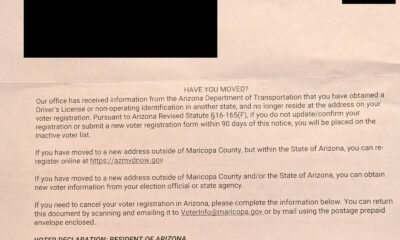arizona
Pinal County Supervisor Urges AZ Attorney General to Probe Primary Election

A Pinal County supervisor, who recently lost his bid for sheriff, has called upon the Arizona Attorney General’s Office to investigate possible irregularities in the county’s primary election results. Republican candidate Kevin Cavanaugh claims a suspicious pattern in the voting data suggests the results may be inaccurate.
Cavanaugh presented his analysis suggesting “strong evidence that cheating has occurred” to Votebeat. However, two independent analysts reviewed the data and found no conclusive proof of wrongdoing or errors. Officials from Pinal County, just southeast of Maricopa County, expressed confidence in the election’s integrity.
A spokesperson from the Attorney General’s Office acknowledged receiving Cavanaugh’s complaint but did not confirm if an investigation would follow. Cavanaugh intends to raise his concerns during the upcoming supervisors’ meeting on Monday, where the election results will be certified.
Cavanaugh’s skepticism stems from observing almost identical results between early and election day ballots in several local races. Traditionally, a noticeable difference exists between these groups’ voting patterns. Cavanaugh pointed out that Arizona Republicans often vote in person on election day, which magnifies his surprise at the nearly matching results.
Analysts Benny White, a Republican, and Sam Almy, a Democrat, stated that the voting patterns flagged by Cavanaugh are curious but not necessarily indicative of fraud or errors. They emphasized the complexity and unpredictability of voter behavior, especially in recent elections.
County Attorney Kent Volkmer, also a Republican, acknowledged the strangeness of the pattern but remains confident in the county’s election process after thorough checks and balances. He stated, “They were able to explain, certainly to my satisfaction, that there was nothing untoward, there is nothing hanky, there is nothing suspicious about this election.”
Recorder Dana Lewis, a Republican who oversees the county’s elections, reinforced this confidence, citing various pre- and post-election tests and hand-count audits. She vehemently dismissed claims that election staff could influence the outcome of any race.
In the past, Pinal County faced scrutiny for failing to count hundreds of votes correctly during the 2022 midterm elections. Corrections were made through a statewide recount, and subsequent process improvements were implemented.
Volkmer, surprised by his primary loss to Cavanaugh ally Brad Miller, acknowledged the unusual consistency between early and election day votes but accepted the results, attributing them to low voter turnout.
Cavanaugh is considering requesting an expanded hand count of the specific races he scrutinized but will wait until after the election results are certified.
Arizona law mandates a hand-count audit of a select number of ballots post-election. However, recent rulings prohibit counties from expanding these audits beyond what state law prescribes. Nevertheless, Volkmer believes broader hand counts could enhance voter confidence.
Democratic Chair Lisa Sanor, who witnessed the election night vote counting, expressed confidence in the results. After discussing with Cavanaugh, she agreed that a targeted hand count would quell concerns for transparency’s sake.
Lewis voiced disappointment in Cavanaugh’s claims, affirming that multiple tests verified the accuracy of the voting machines. She highlighted the robust security measures and continuous monitoring in place during ballot tabulation.
Analysts Almy and White cautioned against drawing hasty conclusions from limited data. Additional data, such as the cast-vote record, could provide more insights. However, Arizona counties do not currently release this database.
Almy pointed out that differences between early and election day votes are more common in high-profile races, and voter behavior in low-turnout local races depends significantly on candidates and campaigns. The disruptions in voting behavior since 2020, partly due to misinformation and the COVID-19 pandemic, further complicate analysis.
White summarized, “It’s easy to look at one set of figures and jump to conclusions. But that’s not necessarily the whole story.”
This article was originally published by Votebeat, a nonprofit news organization covering local election administration and voting access.


















